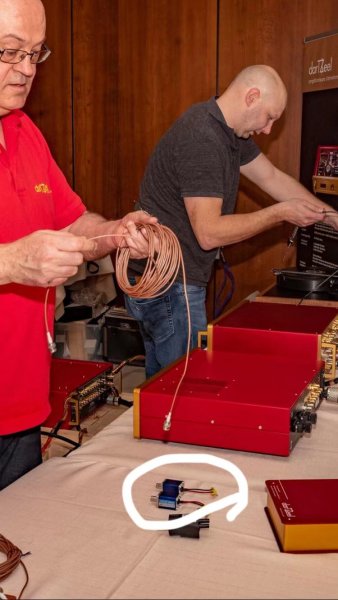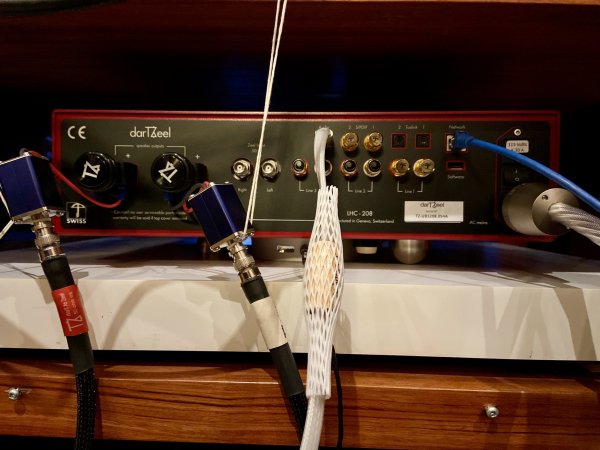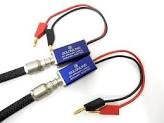dartzeel converter??
- Thread starter dandylinpsst
- Start date
You are using an out of date browser. It may not display this or other websites correctly.
You should upgrade or use an alternative browser.
You should upgrade or use an alternative browser.
Those are Sucobox spade to BNC adapters. They are connected to the speaker outputs of the LHC-208 to attenuate the signal so you can plug The 208 into a preamp and use it as a stand-alone DAC. It seems convoluted but it works remarkably well.
The wire is the standard Dart to Zeel Link 50 ohm BNC cable. 50ohm BNC is the preferred interconnect between DarTZeel components.
The wire is the standard Dart to Zeel Link 50 ohm BNC cable. 50ohm BNC is the preferred interconnect between DarTZeel components.
But there are few coaxial cables on the market for analog signals!!
It is largely a question of marketing and labeling. If BNC became a popular analogue interface lots of digital cables would be discovered to sound good with analogue.
It is largely a question of marketing and labeling. If BNC became a popular analogue interface lots of digital cables would be discovered to sound good with analogue.
maybe? but maybe not.
early in my darTZeel days i did try a number of BNC digital cables in comparison with Herve's own cables and my Evolution Acoustic BNC's.
the generic digital and broadcast (BNC cables were much used in pre-digital commercial TV installations) versions all sounded flat and lifeless. that was 15 years ago now. they worked functionally fine......but were not satisfactory for the music. i still have a bag full of these in my attic upstairs.
i even had Audience build a set of BNC's with their high level interconnect cables, but they did not sound very good. that was when i first got the Evolution's which bettered Herve's cables.
so it's not trivial to find a good quality analog music 50 ohm 'zeel' BNC. Evolution used darTZeel electronics for their design work, and is/was the USA darTZeel warranty place too, so it was a natural fit there and they able to make an optimal 'zeel' cable to my ears.
Last edited:
the generic digital and broadcast
Those used horrible materials. The coax will always remain a compromise because of the need to use the braid as a signal carrying conductor. And because of geometry.
My point was that newer, well regarded digital cables are pretty close to what a really good analogue BNC cable could sound like. There are just too many constraints to develop something dramatically different. Whether the 50ohm termination makes this endeavour worthwhile is another question.
I think van den hul is the first wire manufacturer to introduce coaxial digital wires into analog signal transmission .Their mc-silver it 75 is the standard 75ohm specification ,mc-silver 65g is standard 50ohm specification.But the sound performance in analog used does not seem to be favored by most people?
maybe? but maybe not.
early in my darTZeel days i did try a number of BNC digital cables in comparison with Herve's own cables and my Evolution Acoustic BNC's.
the generic digital and broadcast (BNC cables were much used in pre-digital commercial TV installations) versions all sounded flat and lifeless. that was 15 years ago now. they worked functionally fine......but were not satisfactory for the music. i still have a bag full of these in my attic upstairs.
i even had Audience build a set of BNC's with their high level interconnect cables, but they did not sound very good. that was when i first got the Evolution's which bettered Herve's cables.
so it's not trivial to find a good quality analog music 50 ohm 'zeel' BNC. Evolution used darTZeel electronics for their design work, and is/was the USA darTZeel warranty place too, so it was a natural fit there and they able to make an optimal 'zeel' cable to my ears.
Mike, the pics of your SUTs show some cables that I presume are not BNCs since I it appears they have RCA connectors. But I may be wrong. If they are RCA connectors, may I ask who makes the the white cables that are shown?
Mike, the pics of your SUTs show some cables that I presume are not BNCs since I it appears they have RCA connectors. But I may be wrong. If they are RCA connectors, may I ask who makes the the white cables that are shown?
those white cables are 2 sets of DIN to RCA phono cables. one set i purchased from Found Music (my friend Scott Sheaffer) when i bought my Durand Tosca tonearm. the other set i borrowed from jazdoc who also bought those cables from Found Music, but then liked some other DIN to Phono cables more (from Joel Durand directly) so was not using them (and was nice enough to loan them to me).
those loaner cables will be replaced in a couple of weeks by a set of 'super-uber' DIN to RCA's from LFD (Dr. Richard Bews from the UK).
all the other interconnects in my system are 'zeel' BNC's except some other captured phono cable RCA's (i do have 4 tonearms each needing a tonearm cable)..
sorry to get so detailed, but it's not a simple answer.
those white cables are 2 sets of DIN to RCA phono cables. one set i purchased from Found Music (my friend Scott Sheaffer) when i bought my Durand Tosca tonearm. the other set i borrowed from jazdoc who also bought those cables from Found Music, but then liked some other DIN to Phono cables more (from Joel Durand directly) so was not using them (and was nice enough to loan them to me).
those loaner cables will be replaced in a couple of weeks by a set of 'super-uber' DIN to RCA's from LFD (Dr. Richard Bews from the UK).
all the other interconnects in my system are 'zeel' BNC's except some other captured phono cable RCA's (i do have 4 tonearms each needing a tonearm cable)..
sorry to get so detailed, but it's not a simple answer.
Thanks. I've said it before- having used all BNC's early with my Rowlands in the early 80's, it's a very compelling way to go but unfortunately, most gear is not standardized for it and the issue of adapters is often problematic. I think Herve is to be congratulated for going that way. I've always envied it when you first told me you "don;'t even have to think about cables anymore". The rest of us unfortunately have to suffer, but fortunately, sometimes the results are quite pleasing
ln amateur radio land (which does not enjoy the subjectivity and latitude of high-end audio) we use PL-259/SO-239 for shortwave and VHF (2 meters); BNC for VHF and UHF (70cm) (TNC is a threaded (rather than bayonet) BNC); and N (an upsized and upgraded TNC) for above 70cm.
The locking bayonet BNC (which can support 50 ohm or 75 ohm implementation) certainly is a sturdier connector than the pull-out RCA, but, other than that, what is the reason for its use by darTZeel at audio frequencies?
The locking bayonet BNC (which can support 50 ohm or 75 ohm implementation) certainly is a sturdier connector than the pull-out RCA, but, other than that, what is the reason for its use by darTZeel at audio frequencies?
Last edited:
ln amateur radio land (which does not enjoy the subjectivity and latitude of high-end audio) we use PL-259/SO-239 for shortwave and VHF (2 meters); BNC for VHF and UHF (70cm) (TNC is a threaded (rather than bayonet) BNC); and N (an upsized and upgraded TNC) for above 70cm.
The locking bayonet BNC (which can support 50 ohm or 75 ohm implementation) certainly is a sturdier connector than the pull-out RCA, but, other than that, what is the reason for its use by darTZeel at audio frequencies?
the 50 ohm spec. for the BNC.
if you have the techie chops, read Herve's article in the September 2001 Stereophile magazine about echo's in conventional interconnects. all of them. it mostly has to do with unbalanced impedance. this was written before there was a darTZeel amplifier or even a darTZeel company. the first 108 stereo amp was not introduced until the next year or so.
in theory.......the 50 ohm spec allows an interconnect up to .5 kilometre without signal loss. i use an 11 meter set of 'zeel' BNC's from my King Cello across my room to my preamp. it kills any XLR's i've tried in it's place.
Similar threads
- Replies
- 6
- Views
- 1K
- Replies
- 11
- Views
- 3K
- Replies
- 1
- Views
- 1K
| Steve Williams Site Founder | Site Owner | Administrator | Ron Resnick Site Owner | Administrator | Julian (The Fixer) Website Build | Marketing Managersing |




